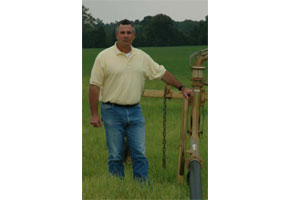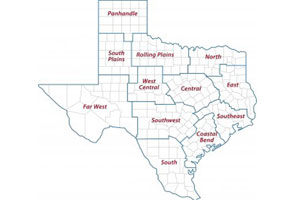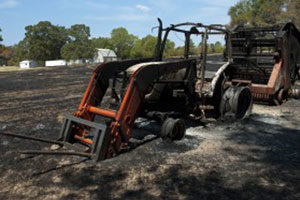In some dry years, that might be a good strategy, but not this one, Redmon said.
“It’s unprecedented,” he said. “(We’ve had) the 12 driest months in Texas history, and there’s just not many ways to combat that.”
With grazing and hay supplies next to non-existent in many areas of the state, it’s getting very expensive to buy feed. On average, it’s costing producers “somewhere around a $100 a month to have these animals (cows) stay in the pasture and feed them,” he said.
Another choice is to move cattle elsewhere, most likely another state during this drought, and lease land where there is grazing, Redmon said.
 “It could be western Mississippi; it could be eastern Louisiana; or it could be maybe Missouri,” he said. ‘I haven’t talked to anybody this year, but in the past couple of years people have called me from other states and they’ve quoted prices of $20 to $22 per (cow/calf) pair per month. Even assuming that’s $25 or $30 that’s still a far, far cry from $100 a month.”
“It could be western Mississippi; it could be eastern Louisiana; or it could be maybe Missouri,” he said. ‘I haven’t talked to anybody this year, but in the past couple of years people have called me from other states and they’ve quoted prices of $20 to $22 per (cow/calf) pair per month. Even assuming that’s $25 or $30 that’s still a far, far cry from $100 a month.”
Of course, one has to add the cost of hauling a trailer load of cattle to the leased grazing, but even with that added cost it still cheaper than trying to buy hay and feed at today’s prices, he said.
“It’s probably going to be $3 to $3.50 a loaded mile –something like that,” he said. “If you just put all that together … the savings could still be tremendous if a person could find a place to put those animals.”
But completely selling out makes more sense yet, Redmon said, given there’s no guarantee this drought will end anytime soon.
“Some people would counter and say it’ll cost more to come back into the business later because conditions will have improved, and more people will be getting back in,” he said. “That’s true. But again, looking at the difference in what it would cost to buy cows and come back in at some later date — versus what they would spend trying to go through this drought — mathematically, it’s just a no-brainer.”
More information on the current Texas drought and wildfire alerts can be found on the AgriLife Extension Agricultural Drought Task Force website athttp://agrilife.tamu.edu/drought/.
AgriLife Extension district reporters compiled the following summaries: 
Central: Northern parts of the district received from 2 to 5 inches of rain, but conditions remained largely unchanged. Sale barns were full each Saturday. Cattle were getting thin. All livestock producers were heavily feeding. Hay and water was in short supply. Farmers continued to harvest crops worth harvesting. Many crops were being zeroed-out for insurance purposes.
Coastal Bend: Though light showers were reported in some areas, extreme drought conditions persisted. The cotton harvest was ongoing. Livestock producers continued to sell off herds due to lack of forage. Most watering ponds were dry. Some water wells were also going dry, and some producers were drilling new ones. Many trees were dying or showing signs of drought stress.
East: No rain was received, and the drought worsened. Water levels in stock ponds and creeks were dangerously low. Many trees were dying or going dormant early. Hay was no longer being harvested. Producers were searching for hay to buy. Out-of-state purchases were becoming more common. Ranchers continued culling and selling off herds. Livestock began to show signs of obvious weight-loss.
North: Soil moisture was very short over most of the area. Daytime highs of 100-plus degrees and nighttime lows in the mid-80s continued to be the norm. A few areas received some rain, which might improve pastures if they are not overgrazed and given time to regrow. Without rain, most pastures continued to go downhill. The corn and grain sorghum harvests were nearly complete with yields reported to be slightly above average. Soybeans – those that survived the drought — were also being harvested. Some soybeans were cut for hay and the rest were being plowed under. Corn and milo stalks were being harvested as hay and shipped all over the state. Where there was hay, it was being sold before it was cut. Once baled, hay was being loaded on trucks and shipped out before the baler got cold. Most livestock producers were feeding hay and supplements to cattle. With heavy supplemental feeding and short hay supplies, producers continued to cull their herds and were scrambling to find hay for immediate feeding and for winter. Some livestock producers were selling out. Water was becoming a major concern as ponds were getting very low. Hay producers hoped for late August or September rains so they could possibly produce one more cutting. Trees were dying from the record heat and lack of rain for over 60 days in most areas. Rangeland and pasture conditions were very poor.
Panhandle: Most of the region received scattered showers and cooler weather. Accumulations ranged from a trace to 1.5 inches. The rain and cooler weather was welcomed, but it was not enough moisture to help the very thirsty crops. Soil moisture levels remained very short. Irrigators were watering full swing trying to keep up with water demands. Gray County received hail along with the rain, which stripped the leaves off some cotton and corn. Also, high winds toppled six pivots in that county. The rain greened up some pastures, but more was needed to really make a difference in the very poor conditions. However, the cooler weather did ease water needs and heat stress on cattle. Supplemental feeding of livestock continued. Producers who were trying to hang on to their cattle were buying hay form other states, with hauling costs running $20-$30 per ton.
Rolling Plains: Rain! But the amount varied greatly from county to county. Throckmorton County received from 0.5 inch to 3 inches of rain, while Stephens County received from 0.5 inch to 5 inches. Haskell County received as much as 2.8 inches. Other counties received from 0.1 to 0.8 inch. However, the majority of counties did not receive any measurable moisture. The rain was no help for cotton producers, though it did help wheat growers who would like to plant in September. More moderate temperatures, especially nighttime lows, helped relieve stress on livestock. Cotton was fruiting, but even under heavy watering, fields still looked weak. Producers were weaning and selling calves. Some producers are selling or shipping their cows to out-of-state grazing. Hay was scarce and expensive when available. A few hay producers hoped to have a late-summer cutting. Large trees were beginning to show the effects of too little moisture.
South: Record-high temperatures continued. In Webb County, temperatures of 104 and higher were reported. Some daytime highs reached 108 or even 110 degrees. Rangeland and pastures further declined, forage supplies and stock-tank water levels dropped. Many livestock water tanks had already completely dried out. In Live Oak County, there were record numbers of livestock sales at sale barns. The heaviest livestock culling was taking place in Webb and Zavala counties, where ranchers have completely run out of water resources. Also, feed sources in those counties were very scarce. The western portion of Frio County received 0.5 to 1 inch of rain. Also in that Frio County, the corn harvest was completed, the cotton harvest began and the sorghum harvest was ongoing. Most crops in Jim Wells County were harvested, and fields were ready for fall and winter preparations. In Zavala County, farmers were preparing land for cabbage and spinach planting, and pecan producers were irrigating orchards in the critical kernel-development stage. In Hidalgo County, the cotton harvesting was winding down. In Starr County, farmers were planting sugarcane and fall vegetables. In Willacy County, harvesting of late-planted cotton continued.
South Plains: Some areas received as much as 3 inches of rain. Others got none. The remaining cotton is from two weeks to a month ahead of schedule; and the final stages of flowering or in cut-out. In other areas, cotton was shedding bolls and squares from lack of water. Of the 42,000 cotton acres planted in Garza County, only 8,000 remained. Many producers were planning on an early harvest. High temperatures dropped into the 90s. Most counties were still under burn bans. Some growers chose to dig and harvest peanut vines for hay due to the low pegging rate. White grapes in Yoakum County were harvested, and red grapes were expected to be ready by the end of August. Cattle producers were selling off herds because of shortages of grass, hay and water.
Southeast: The extreme drought did not budge. The month of July closed with a nearly 22-inch rainfall deficit for the year in some parts of the region. Some areas had scattered showers. Grain sorghum and rice fields were being baled and sold for livestock forage. Early July had brought some light rains that allowed for re-growth of grain sorghum. But tests showed very high prussic acid levels. People feeding this forage to livestock were cautioned to test all sorghum grass species before grazing or feeding as hay. Pond levels continued to drop. The condition of cattle continued to decline with the as pastures worsened. Cattle sales were up. Some infestation of red rice was reported in the rice crop.
Southwest: Sporadic showers brought 1 inch to 2 inches of rain to some areas, but most of the region remained completely dry. High afternoon winds created dust storms. Record high or near-record high temperatures of over 100 degrees aggravated the drought. The region remains in wildfire-alert status. Many stock tanks were dry. Forage availability remained well below average for this time of the year. The cotton, watermelon and cantaloupe harvests were all ongoing. Some farmers planted sweet corn for an early fall harvest. Peanuts, pecans and landscape nursery crops continued to make good progress wherever irrigation water was still available. Ranchers were providing supplemental feed for livestock.
West Central: Extremely hot, dry conditions continued. Wildfire dangers remained very high. Some areas reported scattered showers, but not enough moisture was received to make a difference. The heat has destroyed almost everything planted, including gardens. Rangeland and pastures were in poor condition. Trees in pastures were dying at an alarming rate. Stock-water tanks were very low or completely dry. Ranchers were hauling water to most livestock. Hay supplies were very limited. Producers continued to cull livestock herds. More and more livestock producers are selling out. 
Photos courtesy of Texas AgriLife Extension Servive, Robert Burns.
Top right: Desperate for hay, the owner of this baler and tractor was trying to harvest a parched field of grass on a neighbor's property in East Texas. A spark from the baler ignited hay inside, and the resulting fire spread to more than 100 acres. No houses burned, but the operator lost both machines plus his pickup truck, which was parked nearby, according to witnesses.
Middle left: Dr. Larry Redmon, Texas AgriLife Extension Service state forage specialist, during times of better grazing in East Texas.
Bottom right: The 12 Texas AgriLife Extension Service Districts.








